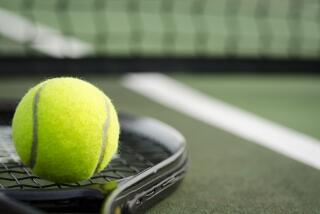Net Gain : Shatto Park Team Serves Notice That Kids From Inner City Are Catching Up to Suburban Peers
- Share via
When 13-year-old Sharon Locsin first picked up a tennis racket last summer at Shatto Park Recreation Center in Westlake, she looked like “Mickey Mantle holding a bat,” said David Smith, her coach.
But within two weeks, any resemblance to the former Yankee baseball star faded as Sharon’s progress evoked images of tennis prodigy Jennifer Capriati.
“I was amazed at her development,” Smith said. “In less than two weeks, Sharon was playing--and beating--people who had been playing for at least two years.”
With an armful of trophies from city and county tournaments, Sharon is winning recognition for a program that didn’t exist before last summer.
Since then, the Shatto team, which defeated a Beverly Hills team in the Oct. 11 Penn Junior Team Tennis League match, has shown that inner-city tennis players are quickly catching up to their suburban counterparts.
The Shatto team formed when Smith recruited 50 young players from the neighborhoods around Shatto Park for a summer program sponsored by the U.S. Tennis Assn. National Junior Tennis League, part of the Amateur Athletic Foundation. The Southern California Tennis Assn. provided administrative support and equipment for the program.
“The USTA is trying to get kids in the inner-city involved in tennis,” said Smith, a mechanical engineer who coaches in the evening and on weekends at Shatto Park, 3191 W. 4th St. “I love kids, and after the riots I wanted to show that all races can do things together and respect each other.”
After the summer program ended, about half of the players continued practicing and now compete in the Penn league, the Little League of tennis. In the last league contest, which pitted boys teams from Shatto and Beverly Hills, Shatto players Jimmy Kim, Eddie Chung, Dean Kim and Joseph Kim scored victories.
Shatto’s first youth tennis program drew African- and Asian-Americans, Latinos and Anglos. On his polyglot team, Smith found that tennis is a universal language.
“If you play tennis, no matter who you are, we can communicate,” Smith said. “And if you play good tennis, you’ll get the respect of your opponents no matter who you are.”
At first, adults who frequented the park grumbled about giving up court time to the younger players. Now, the adults offer encouragement and playing tips.
“It’s like we don’t have just one coach,” said Ann Au, 15, whose improvement through the summer program surprised her coach at Downtown Business High School, a magnet school, and earned her a spot on the varsity team. “Everyone you play helps you, whether they’re a little kid or 70.”
Sharon agreed. “We get to play against all types when we practice at the park . . . killers (who hit the ball hard), lobbers, cheaters and yellers. I’m ready for anything when I get to the tournament.”
Smith’s patience and energy accounts for much of the tennis team’s success, said Jim Settles, coordinator of junior tennis leagues for the Southern California branch of the USTA. “His kids have done well in a very short period of time,” Settles said.
Training helps, but every coach hopes for natural athletes like Sharon.
“I saw her ability right away,” Smith said.
Sharon said she plays “every possible sport,” including varsity volleyball at Pilgrim School, a private school where she is a freshman. Her mother encouraged her to try tennis with the hope that she might earn a college scholarship.
“I played 10 to 12 hours a day and lost eight pounds the first week,” said Sharon, a slim but muscular teen-ager. “But I loved it. It’s something fun, something I can do.”
On Aug. 7 and 8, Sharon won six trophies in the Shatto Park tournament. The next week, she and Kang Kim won a gold medal in mixed doubles at the countywide National Junior Tennis League Championship at the Whittier Narrows Tennis Center. Then, at the Southern California Municipal Athletic Foundation’s tournament at UCLA, Sharon earned a silver medal, despite what Smith said were several questionable calls against her.
“She doesn’t argue calls,” Smith said.
“David taught us to control our tempers,” Sharon said. “If you have a problem, take it out on the ball. And when you win, you don’t gloat. Kill your opponent, but do it with dignity.”
And with physics, thanks to Smith’s engineering background. “I use applied physics when I coach,” he said. “I teach them about the rotation of the ball and how velocity and acceleration can change the spin of the ball.”
Even tiny 7-year-old Sheleena Gardner, who may not understand physics, shows what a little coaching can do as she launches rockets over the net. “I like the forehand shot the best,” she said.
More to Read
Get our high school sports newsletter
Prep Rally is devoted to the SoCal high school sports experience, bringing you scores, stories and a behind-the-scenes look at what makes prep sports so popular.
You may occasionally receive promotional content from the Los Angeles Times.






